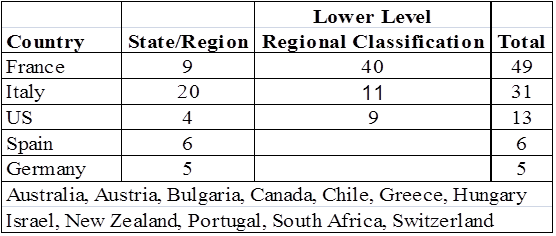Elliott R. Morss, Ph.D. ©All Rights Reserved
Introduction
There are many ways to portray wines. Most have limited value because they do not help drinkers distinguish between wines they like and dislike. This piece reviews the descriptors in use and suggests ones that will be helpful. Before looking at what can be done, consider first the current practice.
Completely Useless Descriptors
Some time back, Richard Quandt wrote an oft-quoted piece: “On Wine Bullshit: Some New Software?” In it, he listed 143 useless descriptors. The following quote wherein he discusses descriptors applied to a Chateau d’Yquem and a Santenay Gravières provides a good sense of his thinking:
“Consider the Yquem. The eight flavors are honey, raisin, jam, quince, fig, hazelnut, orange and mandarin. The last two of these “fill the mouth;” hence they are likely to provide powerful taste sensations. We have only a hint of honey, raisin and jam and the quince, fig and hazelnut have only subtly aromas. Are we being told that these six subtle aromas that are only hinted at are not drowned out by the powerful orange and mandarin flavors? This is bullshit of the first order. For the Santenay Gravières we have to juggle 20 different flavors, from sweaty Pinot fruit to smoky fruit, from pinches of prune, animal (what kind? Lions smell very different from dogs), bread, plus earth, spice, skin, seeds, citrus and oat. The pretense that we shall be able to discern all those tastes and aromas is pure bullshit and only a bullshit artist can claim to be able to do that.”
As I have noted, the professional wine raters such as the Wine Spectator (WS) and Robert Parker use these descriptors endlessly. And one does wonder how tasters working for these companies can keep finding new ways to describe wines.
Another example of useless descriptors: While I do applaud the work that went into the following chart from Wine Folly, it has limited value in helping wine drinkers find wines they will like. And Wine Folly says it is “just the tip of the iceberg!”

Wine Descriptors – The Basics
What information is readily available on wines? From the bottle, we get price, color, and alcohol content. It turns out that price does not predict what people like. From tastings in Paris (1976), Princeton (2012), Stellenbosch (2013), the Lenox Wine Club (2012-14), Lecocq and Visser, Goldstein et al, and Ashton, we have learned that people do not prefer expensive wines to less expensive ones: a wine drinker is just as likely to prefer an inexpensive wine as an expensive one.
Alcohol level and color are important indicators for most people, but further information is needed. There are two other commonly used descriptors:
- The primary grape/varietal of the wine and
- The region/vineyard where the wine “came from.”
These descriptors are great for wine salesmen trying to get customers to buy something “really special.” However, there are problems with both. On grapes/varietals, Kym Anderson at the Wine Economics Research Centre, University of Adelaide, notes “…the Robinson/Harding/Vouillamoz 2012 book called ‘Wine Grapes’ provides a detailed guide to 1,368 commercially grown ‘prime’ varieties.”
Clearly, this number has to be dramatically pared down to be of use to wine drinkers. The same problems hold for information on where the wines “come from”: too many regions, vineyards, etc. To be useful, the numbers of grapes and regions must be reduced.
Reducing the Number of Grapes/Varietals
The wine raters have pared the numbers down. Table 1 gives the count of wines by varietal that Wine Spectator has tasted for the 2004 – 2005 and 2014 – 2015 periods: today, they use 14 reds and 11 whites. To the extent that the wines the Wine Spectator tastes are representative of wine popularity:
- Pinot Noirs have taken over from Cabernet Sauvignon and Blends (“Blends” – a real fudge) as the most popular reds;
- Malbecs has moved up while Shirazes have fallen;
- Chardonnays remain popular while Sauvignon Blancs have gained in popularity.
Table 1. – Wine Spectator’s Tastings of Wine by Varietal

Source: Wine Spectator
* Other red wines tasted but not classified by varietal were 12,536 and 3,332 in 2004-2005 and 2014-2015, respectively.
* Other white wines tasted but not classified by varietal were 4,355 and 3,615 in 2004-2005 and 2014-2015, respectively.
Reducing the Number of Regions, Vineyards, Etc.
Let us again use the regions and vineyards that Wine Spectator employs to organize the wines they taste. The results are shown in Table 2. They taste wines from 17 countries, 44 states/regions, and 60 sub-regions. There can be no question that France and Italy have done well by promoting their wines by region and vineyard.
Table 2. – Wine Spectator’s Tastings by Locale

Source: Wine Spectator
Growth of the “Blends”
One of the problems in using region or grape to describe wines is the rapidly growing number of wines that are described as blends. Of course, most wines are blends in the sense of having small amounts of secondary varietals included. But today, the number of blends not mentioning either region or varietal is growing rapidly. According to the Wine Business Monthly, the growth of such blends has been growing at a 10% annual rate since 2012. A good example is the Barefoot wine brand, the 2nd largest selling brand in the US (18 million nine-liter cases in 2015). They sell 11 red wines of which 4 are blends, 11 “Refresh” wines of which 5 are blends.
I quote from the Wine Business Monthly:
“Red Blend sales continued to grow with the category splitting into segments: There was continued proliferation of so-called “dark” blends, typically made with Cabernet and/or Merlot; then there were the ‘juicy’ Zinfandel-based blends; then a sub category of lighter blends made with Pinot Noir such as Ménage à Trois Silk….. The [blend] category barely existed a couple years ago, but end aisle displays were stacked with them. Red blends range all the way from high-end Napa blends, such as Insignia, to entry-level blends with a hint of sweetness from major producers. Much of the business at $10 to $15 was led by E&J Gallo’s Apothic, Menage à Trois and Ste. Michelle’s 14 Hands.”
Bronco’s Franzia: “The consumer is taking us to a simplified arrangement though red blends. People are blending better wines and not worrying about variety names. The consumer is enjoying those wines because it’s simple for them to say, it’s a Red Blend.”
Moving Forward – My Suggestion
So the share of wines listed by varietals is declining. How can wine drinkers identify wines they will like? I go back to what all wine drinkers can recognize:
- Color – red and white;
- Body – heavy or light;
- Sweetness – dry or sweet.
Color is straight forward. Body can be detected via color and taste: a dark red, e.g., a Malbec, will be “heavy”, a light red, e.g., a Pinot Noir, will be “light”, a heavy white such as a Chardonnay will have some yellow in it while a light white (Sauvignon Blanc) will be primarily white. Sweetness is clearly important to drinkers. Some like dry and some like sweet wines.
There are several arguments for this approach. Perhaps the most important is that people cannot tell the differences between varietals. Sure, one can tell the difference between a light and heavy red. But I would argue (without empirical evidence – a blind taste test needed) that most drinkers cannot distinguish between the heavy reds - Cabernet Sauvignon, Merlot, Shiraz, Malbec or Rioja. I also claim that people have trouble distinguishing between heavy whites, e.g., a Chardonnay vs. an Aligoté and some light whites – a Sauvignon Blanc versus a Pinot Gris.
Table 3 organizes grapes by color and body. I believe this is useful starting point for most wine drinkers. For example, I like heavier reds. So I will stick with the Cabs, Malbecs, Shirazes, Merlots, and Zinfandels. Of course, no classification is perfect. For example, how would a light but very tannin red wine, such a Barolo, be placed?
Table 3. – Varietals by Color and Body

Table 4 provides a link between varietals, region and names for a selected number of wines. Regions have been great marketing vehicles and for that reason will not be given up. In fact, I have argued that with bulk wines readily available, one can expect growing number of wines marketed as coming from highly regarded vineyards that are in fact are made with grapes from other areas.
Table 4. – Regions, Varietals and Wine Names

Conclusions
So with the diminishing use of regions and varietals to describe wines, I conclude a good starting point for all drinkers are color, body and sweetness.
Some might claim their palates demand more sophisticate descriptors. I urge such claimants to consider the findings of Robert Hodgson. Every year, Hodgson selects the finest wines from his small California winery and puts them into competitions around the state. He has found the results surprisingly inconsistent: the awards appeared to be handed out at random. Hodgson has a statistical background and was able to get the organizers of the annual California State Fair wine competition to “test” their judge candidates. Judges were given wines to taste with a number of glasses poured from the same bottle. Hodgson saw the “spread” on how they rated the glasses of wine poured from the same bottle as a good test of their tasting capabilities.
The key result: only about 10% of the judges are consistent in their ratings, and this 10% are not the same judges year to year. He concludes that competition awards have a major random component. And these judges are not amateurs either. They are the who's who of the American wine industry.
Stick with your preferences on color, body and sweetness to choose your wines.



